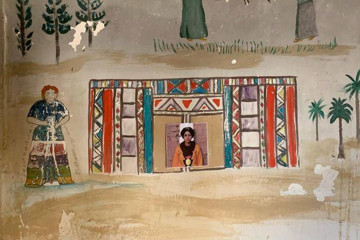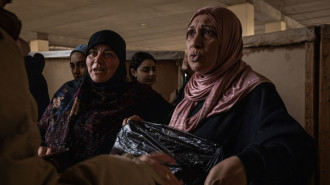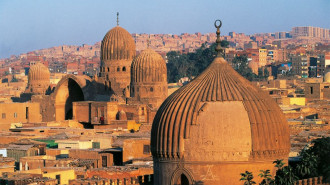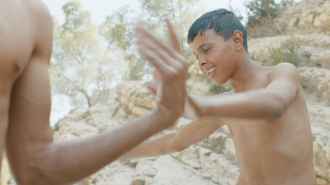
Coexistent Ruins: Exploring Iraq’s Mesopotamian past through contemporary art

After exploring four ancient heritage sites, Ur, Babylon, Nippur and Nimrud, five Iraqi artists have produced videos, photographs and works on burnt canvas and oil which are on display at London University’s Brunei Gallery.
The exhibition Coexistent Ruins: Exploring Iraq’s Mesopotamian past through contemporary art is part of a collaborative visual research project led by Hanaa Malallah with Rayah Abd Al-Redah, Betoul Mahdey, Fatimah Jawdat and Rozhgar Mustafa.
"The exhibition shows how the Iraqis are reclaiming their plundered past in a troubled present and drawing on their rich historical legacy to move forward into a better future"
“It is a long term, interdisciplinary project that seeks to address how it might be possible to have renewed engagements with the four ancient sites and the Archaeological Museum in Baghdad by local Iraqi artists,” Hanaa explained.
“These sites, while still providing security guards and space for international archaeological research, have become derelict during the recent traumatic wars and conflicts. We aim to explore how contemporary collaborative art projects conducted at the sites can produce a renewed engagement with Iraq’s ancient heritage and history. The ancient Mesopotamian heritage which was exploited and plundered by colonisers and invaders needs to be reclaimed by Iraqis.”
The main aim of the project is to assist the small museums at archaeological sites, which have been neglected for many years, to become more responsive to the needs of the local community. Malallah believes Mesopotamia heritage can play a role in shaping Iraq’s current traumatic identity for the future and hopes to generate a renewed interest in the significance of Iraq’s ancient heritage.
The exhibition creates a penetrating flash of insight into the history of the sites and enables visitors to reflect on events in present-day Iraq. It begins with Hanaa’s abstract works and insights into archaeology.
My Country Map using layers of burnt canvas and oil on canvas is deliberately inaccurate. “This borderless map explores my feeling of being trapped by the consequences of the Iraq wars. Cities are positioned randomly with names burned into canvas, reflecting the destruction and fragmentation caused by the wars,” Hanaa said.
She has also altered maps of archaeological sites in Iraq and scribbled over the names of sites that have been destroyed. The map is renamed the plundering of Iraq and next to the legend is the comment “reducing our existence as an Iraqi to just historical archiving materials.”
The meaning of the colonization of Iraqi archaeological heritage in both the past and present is brought to light in the video of the dig house in Nufar. When she visited the site with Fatimah Jawdet in 2018, Hanaa filmed paintings covering three walls of a dig house erected by American excavators in 1948, painted directly onto the walls like frescoes were painting of the Americans set within the Nufar landscape.
Fatimah responded by inserting herself and a picture frame onto the scene depicted on the wall in a symbolic reclaiming of her history from the colonizers. Past and present were put in flux showing a new approach to the legacy of the past.
“We filmed and photographed the dig house on our phones,” Hanaa recalled. “But when back in London I found the video of poor quality so I asked a friend to return to document the building with good equipment. Unfortunately, the American excavators had returned and would not allow him entry. I felt in that moment the meaning of the colonization of our archaeological heritage.”
Betoul Mahdey was fascinated by the numerical inscriptions which were drawn directly onto ancient artefacts in the archaeological museum in Baghdad. Rather than focusing on the objects themselves Betoul's photographs highlighted the inscriptions. Her work was motivated by the sense of loss after the looting of the museum in 2003 and her increasing fear of future looting.
"The main aim of the project is to assist the small museums at archaeological sites, which have been neglected for many years, to become more responsive to the needs of the local community"
Last year Betoul photographed people in the street in Baghdad. She sent the photographs to Hanaa who digitally conflated the coding of the museum artefacts onto the faces of the people. “A system devised by colonialists to classify artefacts now raises a political question about the status of this rich heritage and a loss of identity for the local people through recent wars and looting,” Hanaa said.
Having been forbidden to climb the steps of the ziggurat at Ur due to its unstable structure Abd Al-Redah paid respect to the monument taking up the pose of the dolerite statue dated 2130BC of the King of Gudea ruler of one of the world’s first civilizations at prayer.
In antiquity to visit the ziggurat was to seek both physical and spiritual nourishment. The statue of King Gudea is now in the British Museum. Abd uses a drone to film herself praying at the ziggurat. The trauma is in the present, the therapy comes from the past to help create a better future.
Rozghar Mustafa’s video Walking the Path follows the route made by foreign excavators who covered what they considered to be of value in cloth. The video searches the Nimrud archaeological site in Mosul encountering one of the Assyrian monuments destroyed by the Islamic State group in 2014. When she reaches the Assyrian wall relief of Lamassu, a human-headed winged lion, she spontaneously touches the carved hand that remained intact. Past and present unite and enrich each other.
One of the most thought-provoking artworks is a portrait of Lady Layard painted in 1870 which has been edited by Hanaa Malallah to show Lady Layard wearing “Bomb Wreck Jewellery” instead of the original Assyrian style jewellery.
The first collection, Lady Layard’s Jewellery was made by the Phillips Brothers in 1869 using antiquities pillaged from Iraq. The second collection, Bomb Wreck Jewellery was created from the wreckage of two car bombs that exploded on Al Mutanabbi Street in Baghdad on March 5, 2007. These sets of jewellery each encapsulate two very different processes of ruination; when brought together, they testify to continuing forms of colonial violence and appropriation in the region, whether through archaeological excavations or military occupation.
The exhibition shows how the Iraqis are reclaiming their plundered past in a troubled present and drawing on their rich historical legacy to move forward into a better future.
Karen Dabrowska is a London-based freelance journalist focusing on the Middle East and Islamic Affairs. She is also the author of ten books. Her latest, biography, Mohamed Makiya: A Modern Architect Renewing Islamic Tradition was published by Al-Saqi in July




![Palestinians mourned the victims of an Israeli strike on Deir al-Balah [Getty]](/sites/default/files/styles/image_684x385/public/2024-11/GettyImages-2182362043.jpg?h=199d8c1f&itok=xSHZFbmc)


![The law could be enforced against teachers without prior notice [Getty]](/sites/default/files/styles/image_684x385/public/2178740715.jpeg?h=a5f2f23a&itok=hnqrCS4x)
 Follow the Middle East's top stories in English at The New Arab on Google News
Follow the Middle East's top stories in English at The New Arab on Google News


